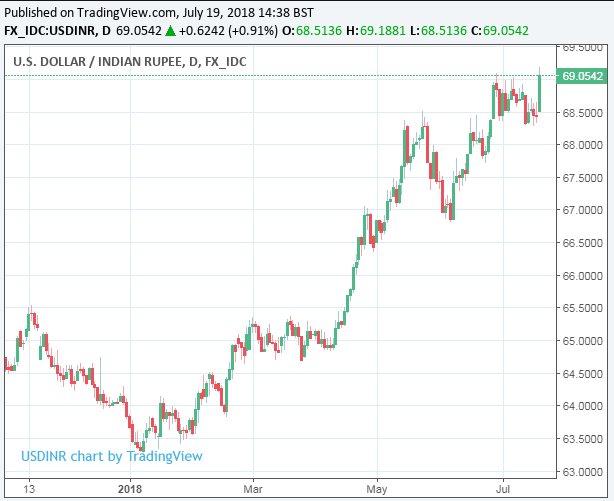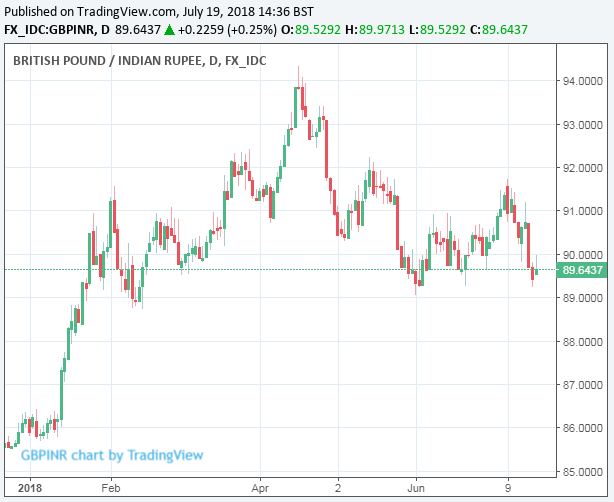Indian Rupee Eyes Relief Rally as Oil Falls and RBI Readies another Rate Hike say TD Securities
- Written by: James Skinner
-
-INR weakens Thursday but relief is around the corner.
-Retreating oil prices and rate hike to support INR in August.
-But more weakness against USD looms ahead of year-end.

© Ash T Productions, Adobe Stock
The Indian Rupee is on the cusp of a relief rally against its emerging market counterparts, say analysts at global investment bank TD Securities, who are arguing that recent declines in oil prices and an anticipated rate hike from the Reserve Bank of India will lift the currency during the weeks ahead.
TD Securities' call comes with the Rupee sitting on a 7.8% loss against the US Dollar for 2018 so far, and on a near-6% loss against Pound Sterling, as investors fled from emerging market currencies in their droves. These losses pushed the Rupee to a record low against the US greenback in early July.
"Although India is not particularly exposed to the impact of US trade tariffs compared to the rest of Asia, it has been impacted by a plethora of adverse factors," says Mitul Kotecha, a senior emerging market currency strategist at TD Securities. "Consequently portfolio outflows from India have increased sharply."
A resurgent greenback, which has converted a 4% 2018 loss into a 3.5% gain during the same time period, and rising US bond yields are at the heart of these moves.
So too are US tax reforms and a double-digit increase in oil prices, which have driven the Dollar and Indian inflation higher, thereby hampering the Rupee and threatening economic growth. President Donald Trump's "trade war" is also exerting increasing upward pressure on the Dollar and downward pressure on the Rupee.
"India won’t escape totally unscathed but the bigger risk for India’s economy is the impact of Fed hikes and US yields. As the Fed has raised rates and US yields have moved higher, India’s current account deficit has rendered the currency relatively more vulnerable than most of its Asian peers. Growing portfolio outflows have meant that the deficit has become harder to fund," says Kotecha.
India's balance of payment deficit is expected to rise this year, thanks largely to changes in the import and export mix as well as due to offshore factors like the events driving the Dollar higher. This has driven international investors out of India and other emerging markets right at the same time as India's trade balance deteriorates in a way that is not favourable to the Rupee.
India's fast growing economy is fuelling increased imports of international goods which, at the most basic level, is problematic because it means more Rupees being dumped on the market in order for companies to buy the other currencies needed to pay for imports. This is bad for both trade and current account balances, which reflect real world supply and demand for a currency.

Above: USD/INR rate shown at daily intervals.
"We noted [on] 25 April 2018 that the pain for INR will not ease quickly and while the RBI has the ammunition to defend the currency, we did not expect anything more than smoothing the short term depreciation path. We highlighted that INR is likely to remain prone to further depreciation pressures in the weeks ahead," says Kotecha. "Since then the INR has fallen further, but we think much of the pain in this bout of weakness is over."
The USD/INR rate was 0.94%% higher at 69.15 Thursday while the Pound-to-Rupee rate was quoted 0.15% higher at 89.67. The USD/INR rate reached a joint all-time high of 69.18 this month, which is an all-time low for the Rupee.

Above: Pound-to-Rupee rate shown at daily intervals.
"In the near term the currency is likely to consolidate, giving opportunities to enter into tactical long INR FX trades, especially versus low carry EM Asia FX such as the Taiwan Dollar and Korean Won. Further out, we envisage a more gradual pace of INR depreciation," Kotecha says. "Similarly we think bond market negativity has reached an extreme, and prospects look somewhat better in the weeks ahead."
Prices of WTI and Brent crude oil had risen by as much as 20% during the six or so months to the beginning of July but recent intervention by President Trump, targeting the Organization for Petroleum Exporting Countries (OPEC), as well as reports of internal debate inside of OPEC have knocked 7% off both benchmarks during the last week alone.
Kotecha says this is a significant positive for the Indian Rupee because India is a large oil importer and the price fall will mean there are less Rupees being sold on international markets in order to pay for oil exports during the months ahead.
"Limited further upside for oil prices will help to reduce upward pressure on inflation while due to favourable base effects, CPI could show some moderation in H2 18. This may allow the RBI some breathing space but is unlikely to be sufficient to prevent the RBI from hiking again once more, likely at the 1 August meeting," Kotecha writes, in a briefing Thursday.
The Reserve Bank of India already announced a surprise interest rate rise back in June, taking the cash rate up to 6.25%, although increasing numbers of economists are now forecasting further rate hikes to come. The Capital Economics team predict Indian interest rates will rise to 6.75% before the year is out, after having correctly predicted the June increase.
This would be positive for the Rupee because, cutting a long story short, it would likely ease capital outflows from India. Interest rates, and speculation about them, are the raison d'être for most moves in currency markets. Changes in interest rates, or hints of them being in the cards, impact currencies because of the push and pull influence they have on international capital flows and their allure for short-term speculators.
"A likely more stable external picture in terms of the USD, Fed rates, US yields, and oil prices, together with some resumption of capital inflows, will help reduce pressure on the INR. We forecast a further 2.1% and 4.0% depreciation of the INR versus USD by end 2018 and 2019 (spot reference 68.54), respectively," says Kotecha.
Kotecha and the TD Securities team forecast the above factors will boost the Indian Rupee relative to other emerging market currencies during the weeks ahead, and that future depreciation relative to the US Dollar will be much more mild than it has been so far in 2018. They forecast the USD/INR rate will rise by 2.1% to 69.97 by the end of 2018 before climbing further, to 71.28 in 2019.
Advertisement
Get up to 5% more foreign exchange by using a specialist provider to get closer to the real market rate and avoid the gaping spreads charged by your bank when providing currency. Learn more here






